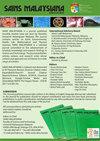无刺蜂产品中分离的芽孢杆菌沉淀碳酸钙的研究
IF 0.8
4区 综合性期刊
Q3 MULTIDISCIPLINARY SCIENCES
引用次数: 0
摘要
通过尿素水解的微生物诱导碳酸钙沉淀(MICCP)是在短时间内沉淀高浓度碳酸钙(CaCO3)的最有效方法。MICCP工艺用于修复混凝土中的微裂纹。然而,对细菌沉淀CaCO3的测定研究有限,尤其是在马来西亚。在此,对从马来西亚无刺蜂产品中分离的芽孢杆菌进行CaCO3沉淀评估。根据芽孢杆菌产生尿素酶的能力选择芽孢杆菌进行进一步研究。尿素酶阳性的芽孢杆菌通过在CaCO3沉淀琼脂和肉汤培养基上培养来筛选CaCO3沉淀。测试了脲酶阳性芽孢杆菌在不同温度、pH值和NaCl浓度下的生存能力。11种芽孢杆菌中有7种被发现是解脲细菌。在解脲细菌中,属于枯草芽孢杆菌物种复合群的细菌显示出能够沉淀CaCO3的细菌数量最多(36.4%)。平流层芽孢杆菌PD6和B.aryabhatai BD8表现出最大的CaCO3沉淀带(15mm)。平流层芽孢杆菌PD6也沉淀出最高量的CaCO3(65mg)和脲酶活性(0.197U/mL)。所有脲酶阳性的芽孢杆菌都能在45°C、pH(8-12)和5%NaCl下生长。只有枯草芽孢杆菌BD3能够承受高达55°C的高温和15%的NaCl浓度。总之,从无刺蜂产品中分离出的芽孢杆菌具有CaCO3沉淀细菌的能力;表明其在自修复混凝土中的潜在应用。本文章由计算机程序翻译,如有差异,请以英文原文为准。
Evaluation of Calcium Carbonate Precipitation by Bacillus spp. Isolated from Stingless Bee Products
Microbiologically Induced Calcium Carbonate Precipitation (MICCP) through urea hydrolysis is the most effective way to precipitate a high concentration of calcium carbonate (CaCO3) within a short time. The MICCP process is used to remediate the micro-crack in the concrete. However, limited research has been conducted to determine CaCO3 precipitation by bacteria, especially in Malaysia. Here, Bacillus spp. isolated from the Malaysian stingless bee products were evaluated for CaCO3 precipitation. Bacillus spp. were selected for further study according to their ability to produce urease enzymes. The urease-positive Bacillus spp. were screened for CaCO3 precipitation by culturing on both CaCO3 precipitation agar and broth media. The survivability of the urease-positive Bacillus spp. in various temperatures, pH values, and NaCl concentrations were tested. Seven out of 11 Bacillus spp. were found as ureolytic bacteria. Among the ureolytic bacteria, bacteria belonging to the Bacillus subtilis species complex group showed the highest number of bacteria (36.4%) that are capable of precipitating CaCO3. Bacillus stratosphericus PD6 and B. aryabhattai BD8 exhibited the largest CaCO3 precipitation zones (15 mm). Bacillus stratosphericus PD6 also precipitated the highest amount of CaCO3 (65 mg) and urease activity (0.197 U/mL). All the urease-positive Bacillus spp. were able to grow at 45 °C, pH (8 to 12), and 5% NaCl. Only B. subtilis BD3 can withstand high temperatures up to 55 °C and 15% NaCl concentration. In conclusion, Bacillus spp. isolated from stingless bee products showed the ability as the CaCO3 precipitating bacteria; suggesting its potential application in self-healing concrete.
求助全文
通过发布文献求助,成功后即可免费获取论文全文。
去求助
来源期刊

Sains Malaysiana
MULTIDISCIPLINARY SCIENCES-
CiteScore
1.60
自引率
12.50%
发文量
196
审稿时长
3-6 weeks
期刊介绍:
Sains Malaysiana is a refereed journal committed to the advancement of scholarly knowledge and research findings of the several branches of science and technology. It contains articles on Earth Sciences, Health Sciences, Life Sciences, Mathematical Sciences and Physical Sciences. The journal publishes articles, reviews, and research notes whose content and approach are of interest to a wide range of scholars. Sains Malaysiana is published by the UKM Press an its autonomous Editorial Board are drawn from the Faculty of Science and Technology, Universiti Kebangsaan Malaysia. In addition, distinguished scholars from local and foreign universities are appointed to serve as advisory board members and referees.
 求助内容:
求助内容: 应助结果提醒方式:
应助结果提醒方式:


